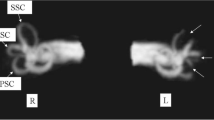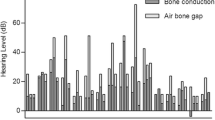Abstract
Objective
Report three cases of simultaneous triple semicircular canal occlusion (TSCO) and cochlear implantation (CI) as the treatment of intractable Meniere’s disease (MD).
Case reports
Patients with MD can present occasionally with intractable vertigo and profound sensorineural hearing loss (SNHL). TSCO and CI have been proposed to control vertigo and restore profound deafness in patients with MD separately. However, a few studies have reported simultaneous TSCO and CI in the same surgical procedure for the treatment of MD. In the present study, we described three patients with MD showing incapacitating vertigo and severe SNHL who underwent simultaneous TSCO and CI after examinations of auditory system, vestibular system, and imaging. Their symptoms were significantly alleviated during the follow-up period.
Conclusion
The combined TSCO and CI remains a viable treatment option which is effective for the control of vertigo as well as the restoring of hearing in patients with MD.



Similar content being viewed by others
Data availability
The raw data supporting the conclusions of this article will be made available by the authors, without undue reservation.
References
Lopez-Escamez JA, Carey J, Chung WH et al (2015) Diagnostic criteria for Meniere’s disease. J Vestib Res 25(1):1–7
Lopez-Escamez JA, Vela J, Frejo L (2023) Immune-related disorders associated with Meniere’s disease: a systematic review and meta-analysis. Otolaryngol Head Neck Surg. https://doi.org/10.1002/ohn.386
Parra-Perez AM, Lopez-Escamez JA (2023) Types of inheritance and genes associated with familial Meniere disease. J Assoc Res Otolaryngol. https://doi.org/10.1007/s10162-023-00896-0
Schuknecht HF (1984) The pathophysiology of Meniere’s disease. Am J Otol 5(6):526–527
Basura GJ, Adams ME, Monfared A et al (2020) Clinical practice guideline: Meniere’s disease. Otolaryngol Head Neck Surg 162(2_suppl):S1–S55
Espinosa-Sanchez JM, Lopez-Escamez JA (2020) The pharmacological management of vertigo in Meniere disease. Expert Opin Pharmacother 21(14):1753–1763
Wright T (2015) Meniere’s disease. BMJ Clin Evid 2015:0505
Nevoux J, Franco-Vidal V, Bouccara D et al (2017) Diagnostic and therapeutic strategy in Meniere’s disease. Guidelines of the French otorhinolaryngology-head and neck surgery society (SFORL). Eur Ann Otorhinolaryngol Head Neck Dis 134(6):441–444
Fife TA, Lewis MP, May JS et al (2014) Cochlear implantation in Meniere’s disease. JAMA Otolaryngol Head Neck Surg 140(6):535–539
Mick P, Amoodi H, Arnoldner C et al (2014) Cochlear implantation in patients with advanced Meniere’s disease. Otol Neurotol 35(7):1172–1178
Lustig LR, Yeagle J, Niparko JK et al (2003) Cochlear implantation in patients with bilateral Meniere’s syndrome. Otol Neurotol 24(3):397–403
Yin S, Chen Z, Yu D et al (2008) Triple semicircular canal occlusion for the treatment of Meniere’s disease. Acta Otolaryngol 128(7):739–743
Loureiro RM, Sumi DV, Lemos MD et al (2019) (2019) The role of magnetic resonance imaging in Meniere disease: the current state of endolymphatic hydrops evaluation. Einstein (Sao Paulo) 17(1):eMD4743
Perez-Carpena P, Lopez-Escamez JA (2020) Current understanding and clinical management of Meniere’s disease: a systematic review. Semin Neurol 40(1):138–150
Küppers P, Ahrens H, Blessing R (1994) Continuous intratympanic gentamycin infusion in Meniere disease. HNO 42(7):429–433
Doobe G, Ernst A, Ramalingam R et al (2015) Simultaneous labyrinthectomy and cochlear implantation for patients with single-sided Meniere’s disease and profound sensorineural hearing loss. Biomed Res Int 2015:457318
Silverstein H, Jackson LE (2002) Vestibular nerve section. Otolaryngol Clin North Am 35(3):655–673
Zhang Y, Cheng Y, Chen Z et al (2021) Case report: preservation of otolithic function after triple semicircular canal occlusion in a patient with intractable Meniere disease. Front Neurol 12:713275
Jiang Y, Xu M, Yao Q et al (2022) Changes of vestibular symptoms in Meniere’s disease after triple semicircular canal occlusion: a long-term follow-up study. Front Neurol 13:797699
Vallés-Varela H, Royo-López J, Carmen-Sampériz L et al (2013) The cochlear implant as a tinnitus treatment. Acta Otorrinolaringol Esp 64(4):253–257
Acknowledgements
The authors would like to thank all the subjects who participated in this study.
Funding
This study was supported by the National Natural Science Foundation of China (Nos. 82171137, 81970891, and 81970876), The Key International Cooperation Project of Shaanxi Province (Grant No. 2020-KWZ-019), Technology Project of Shanghai Science and Technology Commission (Grant No. 21S31900600), and Clinical Research Plan of SHDC (Grant No. SHDC2022CRD013).
Author information
Authors and Affiliations
Contributions
Investigation, QX; data collection, QX, QW, QZ, and JS; writing—original draft preparation, QX; writing—review and editing, QZ, JY, MD, and JAL-E. All authors contributed to manuscript revision and approved the submitted version.
Corresponding authors
Ethics declarations
Conflict of interest
The authors declare that the research was conducted in the absence of any commercial or financial relationships that could be construed as a potential conflict of interest.
Research involving human participants and/or animals
The report was approved by Ethics Committee of Xinhua Hospital Affiliated to Shanghai Jiaotong University School of Medicine (No. XHEC-D-2023-050) and complied with the ethical standards. No animals were involved.
Informed consent
Written informed consent was obtained.
Additional information
Publisher's Note
Springer Nature remains neutral with regard to jurisdictional claims in published maps and institutional affiliations.
Rights and permissions
Springer Nature or its licensor (e.g. a society or other partner) holds exclusive rights to this article under a publishing agreement with the author(s) or other rightsholder(s); author self-archiving of the accepted manuscript version of this article is solely governed by the terms of such publishing agreement and applicable law.
About this article
Cite this article
Xiao, Q., Wu, Q., Zhang, Q. et al. Treatment of Meniere’s disease with simultaneous triple semicircular canal occlusion and cochlear implantation. Eur Arch Otorhinolaryngol 281, 1603–1608 (2024). https://doi.org/10.1007/s00405-023-08387-x
Received:
Accepted:
Published:
Issue Date:
DOI: https://doi.org/10.1007/s00405-023-08387-x




